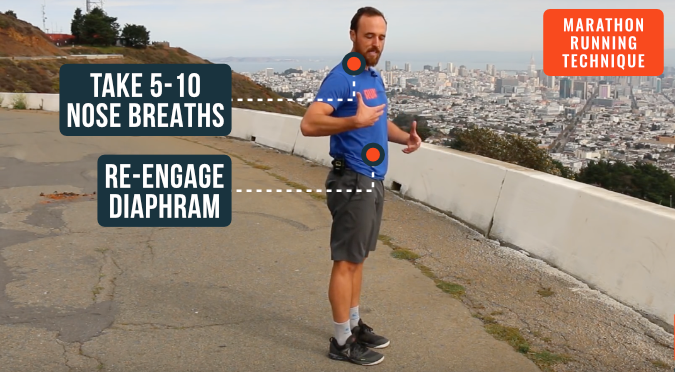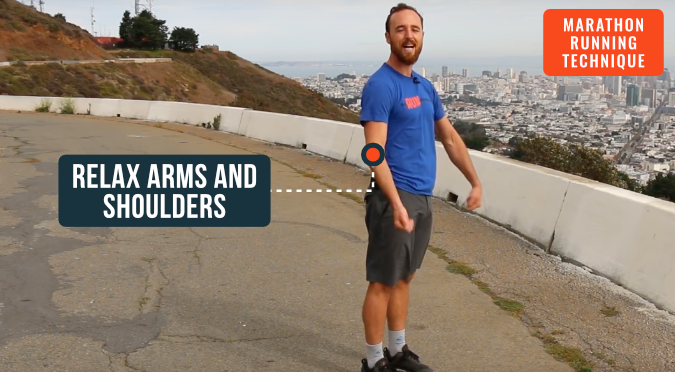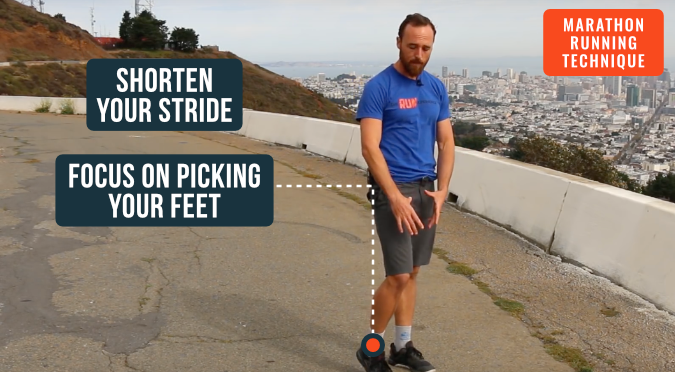How to Prevent Cramps While Running (Causes & Cures)
How do you prevent cramps while running? Learn what causes them and learn some techniques to avoid cramps when running your next race.

Ever had a great run derailed by that all-too-familiar muscle twinge? If we had a nickel for every time a runner asked us how to prevent cramps while running — well, let's just say we'd have enough for a pretty sweet pair of running shoes.
But here's the thing: learning how to avoid cramps when running isn't rocket science. With a little know-how about what causes those pesky cramps and some smart strategies to keep them at bay, you'll be cruising through your next training run or race feeling strong and cramp-free.
So whether you're a newbie wondering how to not get cramps while running or a seasoned pro looking to fine-tune your approach, we've got you covered. We're about to dive into the nitty-gritty of running cramps — why they happen, how to prevent them, and what to do if they strike mid-stride.
How to Prevent Cramps While Running
We’ll get into how to prevent cramps while running in a second, but let’s start with something a bit more important. How about why you get cramps when you run? That sounds like a good place to start.
What Causes Cramps When Running?
Not sure why you cramp when you run? Some people blame it on being out of shape—others say it’s just part of the sport.
Most of what we hear about how to prevent cramps when running centers around electrolytes, salt tablets, and hydration—all things to consume.
While these (or a lack of these) can cause cramps when running, they don’t address everything. These factors do play a big role in preventing and helping to remedy these cramps, and it’s important to understand them. Additionally, there are also some mechanical elements that we can control on our end, as the runner, to prevent cramps while running.
A marathon is 26.2 miles of putting one foot in front of the other, without much change in body position. While many of us start the race with great, upright posture and a steady foot strike, we don’t always finish that way.
Leg cramps running can creep up when your form falls apart. The hamstrings, quads, and calves tend to take the fall first.
You might also end up with a side stitch or a stomach cramp.
Let's look at all the causes of cramps while running:
- Dehydration and Electrolyte Imbalance: One of the most common causes of muscle cramps is dehydration. When you're dehydrated, your muscles are more prone to cramping. Additionally, an imbalance in electrolytes (such as sodium, potassium, magnesium, and calcium), which are vital for muscle function and fluid balance, can also lead to cramps.
- Muscle Fatigue and Overuse: Pushing your muscles beyond their current level of fitness can lead to cramping. This is often seen in long-distance runners or those who significantly increase their intensity or duration of running without adequate training.
- Inadequate Warm-Up: Not warming up sufficiently before a run can predispose your muscles to cramping. A proper warm-up increases blood flow to the muscles, making them more pliable and less prone to cramping.
- Poor Nutrition: Inadequate nutrition, especially low levels of essential nutrients that affect muscle function, can contribute to cramps. This includes not just what you eat before a run, but also your overall diet.
- Running in High Temperatures: High temperatures and humidity can increase the risk of cramps. These conditions not only contribute to quicker dehydration but also cause your muscles to work harder, increasing the chance of cramping.
- Inadequate Recovery: Insufficient rest and recovery after intense workouts can lead to muscle fatigue, which increases the risk of cramping in subsequent runs.
7 Tips for How to Avoid Cramps When Running
Whether you're training for a marathon or simply enjoying a morning jog, implementing effective strategies to avoid cramps can make all the difference. In this section, we'll explore seven practical tips that can help you keep cramps at bay, ensuring a more consistent and rewarding running journey.
From hydration to training techniques, these tips are designed to help you run longer, stronger, and without the interruption of painful muscle spasms.
1. Hang Onto Good Form To Prevent Cramps

The hamstrings and quads should always be working together when you run. They’re like partners in your leg, working to push and pull your leg as you stride forward. If one is picking up the slack for the other, muscle fatigue is likely to set in, leading to cramping.
Especially in a long-distance run like the marathon, good form powered by leg strength and balance is important.
The hamstrings cramp when:
- The upper body rounds forward, causing the low back sinks into a default arch (anterior pelvic tilt)
- Your hips start to sink back
- This lets the glutes turn off, which leave the hamstrings to drive the stride alone
The quads cramp when:
- Your foot strike becomes a shuffle and your cadence slows down
- The hamstrings aren’t working to pick the feet up off the ground
- This causes your feet to spend more time pounding into the ground than they are lifting off of it
- Your quads (both lateral and medial aspects) take all the impact
The calves cramp when:
- The hips are no longer pushing forward.
- Your hamstrings stop working to pull your feet off the ground, slowing your cadence
- The feet begin landing in all kinds of varying positions.
- Results in the calf muscles figuring out how to absorb the impact
Check out more information about maintaining solid run form with Coach Nate:
2. Avoid Stomach Cramps and Side Stitches
While the mechanics of your running tend to hit the muscles mentioned above, there are also other ways to avoid cramps.
Stomach Cramps
While it’s important to remember to hydrate throughout your day and also during a training session, there’s also a balance to strike. Overhydrate before you go out for your jog and you’ll probably feel like you have a gallon of water jostling around in your stomach. Not the best feeling when you’re working out.
- A better strategy is to sip throughout the day so you’re not chugging your daily water quota all at once. When you’re heading out for a run, take a small handheld bottle with you with enough electrolytes mixed with your water to sustain your effort.
- Don’t forget that hot or humid weather conditions will put a greater demand on your body so you might need to adjust for those conditions. It might be tempting to drink a bunch of water at once because you’re heating up, but that’s a sure recipe for a stomach cramp. So remember to sip slowly and consistently so your stomach stays happy.
Side Stitches
Oxygen fuels the muscles just as much as our hydration and calorie intake. Most runners have probably experienced the shooting pain of a side stitch or cramp in their ribs. What causes this type of muscle spasm?
One theory is that as the demand on the diaphragm, the big muscle under your lungs, increases, the likelihood of a side cramp also increases. Let’s look at what that means.
Under normal, everyday circumstances, our breathing tends to stay in our chest and shoulders. So instead of taking a full breath, we’re taking in a shallow amount of air.
Then, when you start running and working harder you need to take in more air to meet your body’s demand for oxygen. So you start breathing more rapidly, or maybe you take in a larger breath.
In response to these more frequent or larger breaths, the diaphragm can sometimes spasm because it’s not used to working so hard. Just like when you push the pace and your calf cramps, your diaphragm can cramp due to the overuse.
- Instead, practice how to breathe deeply with control. On your next inhale (yep, even while you’re reading this) try to pull your breath further down into your belly. As you fill your lungs, focus not only on expanding your chest, but also allowing your ribs to expand. Imagine your ribs flexing front to back, side to side.

As your ribs move, your diaphragm will also start to engage. Think of this practice like a training plan for your diaphragm. Don’t spring it on your body mid-race! Getting your brain and your body used to this way of breathing will take time but will pay off in preventing side stitches!
To dial in that deeper breathing through the diaphragm, practice 5-10 deep nose breaths (mouth closed) every 30 minutes or so during your long run.
3. Avoid Cramps With the Right Hydration Strategy
Like we said before, the heat, hydration, and electrolyte imbalances all play a role in keeping those muscle cramps at bay. While there are general guidelines on how many milligrams and ounces you should be consuming, it’s all personal and dependent on the day.
We recommend experimenting to see what works for you. While you can definitely over hydrate, it’s much harder to do than dehydrate. Take extra water and dial in exactly how much you’ll need over time.
4. Hone Your Breathing
The potential causes for muscle cramps are all great things to practice during your training. Make sure to practice deep breathing while running.
Get your breathing right, and you can contract your muscles in a more efficient way to avoid cramping. Overwork your lungs and your core muscles with inefficient breathing, and you’ll find yourself cramping faster.
5. Warm Up Properly
Start off strong by warming up before your next run. Whether it’s your weekly hill session or your long-awaited half marathon, a thorough warm up will go a long way to avoiding muscle cramps.
By moving your body through a series of movements like bodyweight squats, arm swings, and hip circles, you’ll increase blood flow to all your muscles. You’ll also get your joints ready for running by moving them through their full range of motion.
Don’t get stuck by not knowing how best to warm up. Follow along with this quick, dynamic warm up and make it a regular part of your training and racing routine!
6. Relax The Upper Body

In a long race, it’s very common to get stuck with those shoulders squeezed up to the ears, the arms bent tight to our sides, and little to no arm swing helping us drive the legs.
To undo this, take a few steps to shake the arms and shoulders out, maybe even raising the arms up above your head.
This will help reset your arm swing, which will, in turn, reset the power in your stride.
7. Shorten Your Stride

Cramps tend to creep in when we’re overextended in our stride. The further the foot reaches out in front of you, the more the body has to do to keep up.
Instead, try drawing your focus to pulling the feet off the ground, using the hamstrings. This will keep your feet close to under you, and avoid having them far in front of your body.
Picking the feet up a little higher will also turn on the hamstrings and glutes, allowing the hips to drive forward again. For more help on the pulling technique, check this out.
Quick Fixes: What to Do When Cramps Strike Mid-Run
Sometimes, despite our best efforts, cramps can still crash the party. Don't worry — we've got some on-the-go tricks up our running sleeves:
The stop-and-stretch: pause and give that cramping muscle some TLC
- For calf cramps: step back into a lunge, pressing your heel down
- For side stitches: raise the arm on the affected side and lean away from the pain
The breath work: deep, belly breaths can help ease diaphragm cramps
- Inhale deeply through your nose for 4 counts
- Exhale slowly through your mouth for 6 counts
- Repeat until the cramp eases
The salt trick: a quick electrolyte boost can work wonders
- Carry a small packet of salt or an electrolyte tab
- Place it under your tongue and let it dissolve
The pace adjustment: sometimes slowing down is the way forward
- Reduce your speed until the cramp subsides
- Gradually build back up to your previous pace
Remember, these are quick fixes — not long-term solutions. If you find yourself constantly reaching for these mid-run remedies, it might be time to revisit your prevention strategies.
Mythbusters: Common Misconceptions About Running Cramps
Let's face it — the running world is full of old wives' tales and locker room advice. When it comes to cramps, separating fact from fiction can be tougher than that last mile of a marathon. But don't worry, we're here to play mythbuster and set the record straight!
Myth #1: "Cramps are always caused by dehydration or lack of electrolytes"
The truth: While hydration and electrolytes play a role, they're not the whole story. Factors like muscle fatigue, poor form, and inadequate training can also lead to cramps.
What to do instead: Focus on overall preparation — proper training, good form, and yes, staying hydrated.
Myth #2: "Pickle juice cures cramps instantly"
The truth: While some swear by it, the science is mixed. Any effect is likely due to the strong taste triggering a neurological response, not the salt content.
What to do instead: If it works for you, great! But don't rely on it as your only cramp prevention strategy.
Myth #3: "You should always push through a cramp"
The truth: Forcing a cramping muscle to keep working can lead to injury.
What to do instead: Listen to your body. It's okay to slow down or take a short break to stretch.
Myth #4: "Cramps only happen to out-of-shape runners"
The truth: Even elite athletes experience cramps. They can happen to anyone, regardless of fitness level.
What to do instead: Focus on proper training and prevention strategies, no matter your experience level.
Myth #5: "Eating bananas will prevent all cramps"
The truth: While bananas are a good source of potassium, they're not a magical cramp cure-all.
What to do instead: Maintain a balanced diet rich in various electrolytes, not just potassium.
Myth #6: "Static stretching before a run prevents cramps"
The truth: Static stretching cold muscles can actually increase your risk of injury and doesn't necessarily prevent cramps.
What to do instead: Opt for a dynamic warm-up to prepare your muscles for the run ahead.
Remember, every runner is different. What works for your running buddy might not work for you. The key is to experiment, listen to your body, and find what keeps you running strong and cramp-free!
Stop Cramps When Running for Good
The key in how to prevent muscle cramps is focusing on what you do have control over. Give these cramping-prevention strategies a try the next time you’re pushing through the second half of a race.
One day (hopefully, a not to distance day), you’ll finish a run and realize cramping was never a factor. Trust us, the day will come. Just trust the process.

Looking for more ways to crush your next race? Download our new mobile app for fresh workouts, full training plans, and a community of coaches and fellow runners!
